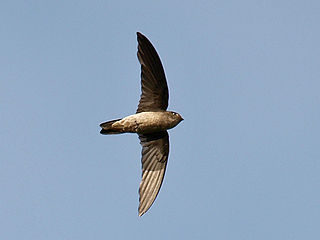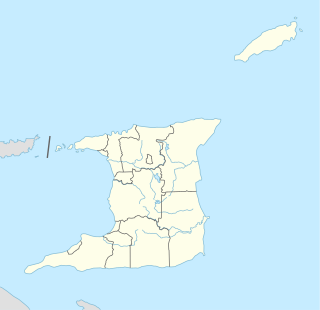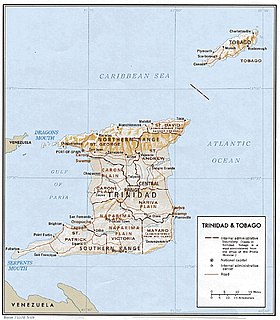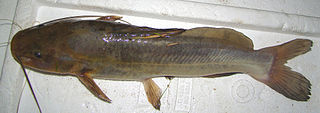Related Research Articles

The oilbird, locally known as the guácharo, is a bird species found in the northern areas of South America including the island of Trinidad. It is the only species in the genus Steatornis and the family Steatornithidae. Nesting in colonies in caves, oilbirds are nocturnal feeders on the fruits of the oil palm and tropical laurels. They are the only nocturnal flying fruit-eating birds in the world. They forage at night, with specially adapted eyesight. However they navigate by echolocation in the same way as bats, one of the few birds to do so. They produce a high-pitched clicking sound of around 2 kHz that is audible to humans.

Swiftlets are birds contained within the four genera Aerodramus, Hydrochous, Schoutedenapus and Collocalia. They form the Collocaliini tribe within the swift family Apodidae. The group contains around thirty species mostly confined to southern Asia, south Pacific islands, and northeastern Australia, all within the tropical and subtropical regions. They are in many respects typical members of the Apodidae, having narrow wings for fast flight, with a wide gape and small reduced beak surrounded by bristles for catching insects in flight. What distinguishes many but not all species from other swifts and indeed almost all other birds is their ability to use a simple but effective form of echolocation to navigate in total darkness through the chasms and shafts of the caves where they roost at night and breed. The nests of some species are built entirely from threads of their saliva, and are collected for the famous Chinese delicacy bird's nest soup.

Aerodramus is a genus of small, dark, cave-nesting birds in the Collocaliini tribe of the swift family. Its members are confined to tropical and subtropical regions in southern Asia, Oceania and northeastern Australia. Many of its members were formerly classified in Collocalia, but were first placed in a separate genus by American ornithologist Harry Church Oberholser in 1906.

The bearded bellbird also known as the campanero or anvil-bird, is a passerine bird which occurs in northern South America. The male is about 28 cm (11 in) long with white plumage apart from a brown head and black wings. At his throat hang several black, unfeathered wattles. The female is a little smaller with olive-green head and upper parts, yellow underparts streaked with green and a yellow vent area. The male has a loud, repeated metallic hammering call, as well as various other vocalisations.

The Asa Wright Nature Centre and Lodge is a nature resort and scientific research station in the Arima Valley of the Northern Range in Trinidad and Tobago. The centre is one of the top birdwatching spots in the Caribbean; a total of 256 species of birds have been recorded there. The centre is owned by a non-profit trust.

The Northern Range is the range of tall hills across north Trinidad, the major island in the Republic of Trinidad and Tobago. The hills range from the Chaguaramas peninsula on the west coast to Toco in the east. The Northern Range covers approximately twenty-five percent of the land area of Trinidad.

El Cerro del Aripo, at 940 metres (3,084 ft), is the highest point in the Republic of Trinidad and Tobago. It is part of the Aripo Massif and is located in the Northern Range on the island of Trinidad, northeast of the town of Arima.

Trinidad and Tobago are continental islands with a geologically very recent history of direct land bridge connection to South America. As a result, unlike most of the Caribbean Islands, Trinidad and Tobago supports a primarily South American flora and fauna and has greater diversity of plant and animal species than the Antilles. However, rates of endemism are lower than in the rest of the Caribbean because there has been less time for genetic isolation from mainland populations because of the history of land bridge connections and hence fewer opportunities for speciation, and so a greater proportion of the species in Trinidad and Tobago are also found on the South American mainland. Trinidad is nearer to mainland South America and has been directly connected to the mainland via land bridges more often and for longer periods than Tobago. This, as well as Trinidad's larger size and more varied topography and hydrology compared to that of Tobago allow greater species and ecosystem diversity on the former compared to that on the later of the islands.

Cutervo National Park , established in 1961, is the oldest protected area in Peru. It is located in the northern Peruvian Andes, in the region of Cajamarca. The park was extended to 8,214 hectares (31.71 sq mi) and protects areas of Andean montane forests and paramo for headwater conservation. Moreover, those areas are the habitat of animal species like the spectacled bear, the mountain tapir, and the oilbird; and plant species like the Andean wax palms.

The Heptapteridae, or three-barbeled catfishes, are a family of catfish that originate from the Americas. Most species are restricted to South America, but Imparfinis lineatus, Nemuroglanis panamensis and Pimelodella chagresi are native to Panama, and Rhamdia species occur as far north as Mexico. The name Heptapteridae is derived from Greek, hepta meaning seven and pteron meaning fin.

David William Snow was a celebrated English ornithologist born in Windermere, Westmorland.

The hairy-legged myotis is a species of mouse-eared bat. It is found from southern Tamaulipas in Mexico, through much of Central America and across northern South America as far east as Trinidad. Further south, it is found along the foothills of the Andes as far south as northern Argentina.
The juil ciego or blindwhiskered catfish is a species of three-barbeled catfish endemic to Mexico. This species is troglobitic, inhabiting a certain stream that flows through a single cave system.

Rhamdia is a genus of three-barbeled catfishes found in Mexico, Central and South America. These catfishes are nocturnal, opportunistic carnivores, found in a wide range of freshwater habitats. This genus includes a number of troglobitic members, encompassing a number of taxa, including R. enfurnada, R. guasarensis, R. laluchensis, R. laticauda, R. macuspanensis, R. quelen, R. reddelli and R. zongolicensis. In a few of these only some of their populations are troglobitic.
Rhamdia zongolicensis is a species of three-barbeled catfish endemic to Mexico. Its specific name refers to Zongolica, the area in Veracruz state where it occurs. It is a cave fish similar to Rhamdia laticauda and Rhamdia reddelli, and at times considered a junior synonym of the former.
Aripo Cave is a cave in the Northern Range, in Trinidad and Tobago. This is the longest accessible cave in Trinidad and Tobago, with 862 m length and 160 m depth. It is one of several caves created by recrystallised limestone. The cave is a notable bat roost, and that bats contribute considerable amounts of guano, which in turn support vast numbers of cave-dwelling invertebrates.
Dunston Cave is an igneous cave on the Northern Range of Trinidad and Tobago. The cave is located on the grounds of the Asa Wright Nature Centre. Originally named Guacharo Cave, it was renamed Dunston Cave in 1972 in honour of engineer John Dunston. The caves are home to an Oilbird colony. These are the only nocturnal fruit eating birds in the world. They forage at night, navigating by echolocation in the same way as the bats.
La Vache is a cave in located in the Northern Range, on the north coast of Trinidad. The Caves are home to the Oilbirds, These are the only nocturnal fruit eating birds in the world. They forage at night, navigating by echolocation in the same way as bats.
Lopinot Cave is a large cave in the Lopinot Valley in the Northern Range of Trinidad and Tobago. The Caves are home to the Oilbirds. These are the only nocturnal fruit eating birds in the world. They forage at night, navigating by echolocation in the same way as bats. It is a 1.5 hour drive from the capital

Cavefish or cave fish is a generic term for fresh and brackish water fish adapted to life in caves and other underground habitats. Related terms are subterranean fish, troglomorphic fish, troglobitic fish, stygobitic fish, phreatic fish and hypogean fish.
References
- Aldemaro Romero. (2002). "Replacement of the Troglomorphic Population of Rhamdia quelen (Pisces: Pimelodidae) by an Epigean Population of the Same Species in the Cumaca Cave." Copeia, Vol. 2002, December 2002.
- Snow, D.W. (2008). Birds in Our Life. William Sessions Limited. ISBN 978-1-85072-381-3 (pbk).